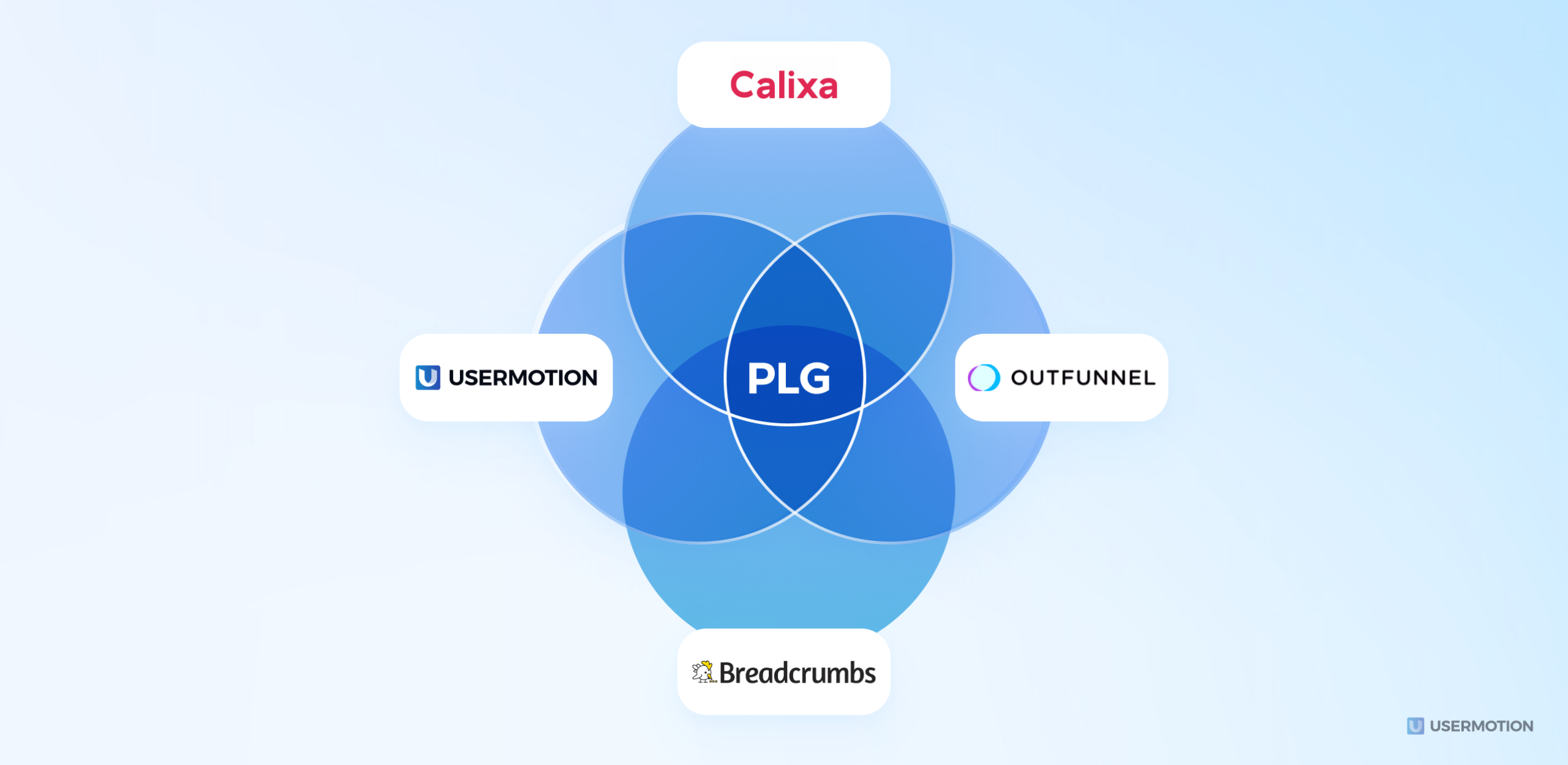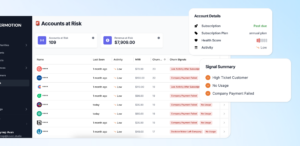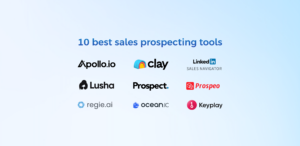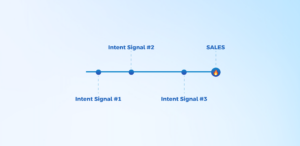Calixa is a product-led sales platform that gives your sales team the product insights and workflows they need to prioritize, close, and grow accounts.
Top 10 alternatives to Calixa
- UserMotion
- Outfunnel
- Breadcrumbs
- Madkudu
- Pocus
- Toplyne
- Journy.io
- HeadsUp
- FunnelStory
- Salespanel
There are 3 top alternatives you can think of when deciding a PLG solution depending on your company’s size and needs.
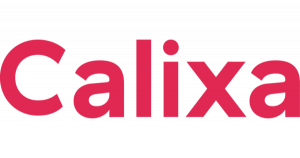



| Target | Revenue Teams | Small to medium B2B SaaS companies | Enterprise companies | Small to medium companies |
| Focus | Product-led Sales | Predictive Lead Scoring | Lead Scoring | Product-led Growth |
| Value Proposition | Empower revenue teams with the data they need to discover and act on expansion and upsell opportunities | Identify accounts most likely to buy, expand, or churn and engage through best practice playbooks | Enterprise-grade lead scoring made for everyone | Data connection platform designed for sales and marketing app |
| Support | Basic support for Growth, Dedicated CS Manager for Enterprise | Dedicated CS Team for All Plans | Email Support for Free and Pro, Dedicated CSM for Business, Dedicated Slack Channel for Enterprise | Email and Chat for Basic + Call for Professional, + Custom Onboarding for Enterprise |
| Free Trial/ Free Plan | Free Plan | Free Plan + Free Trial | Free Plan | Yes |
| Pricing | Starts from $0/m | Starts from $0/m | Starts from $0/m | Starts from $29/m |
| Integrations | Salesforce, HubSpot, Marketo, Segment, Slack, Outreach, SalesLoft, Snowflake, BigQuery, Redshift, Census | HubSpot, Intercom, Pipedrive, Salesforce, Close CRM, Postgres, Segment, Stripe, Paddle, Outreach, Slack | HubSpot, Intercom, Salesforce, ActiveCampaign, Marketo, Mixpanel, Segment, MailChimp | HubSpot, Salesforce, Copper, Pipedrive |
Understand Each Product-led Sales Platform

Calixa is a product-led sales platform designed to help sales teams turn sign-ups into revenue by prioritizing and engaging with leads based on product usage and customer fit data.

Outfunnel a marketing automation platform that emphasizes the connection between sales and marketing data, offering features like CRM integration, email marketing, and lead scoring to streamline workflows and enhance lead nurturing.

Breadcrumbs offers advanced lead scoring and revenue acceleration by combining real-time intent signals with traditional scoring methods, aiming to optimize lead quality and boost conversions through data-driven insights and AI-enhanced models.
Feature Comparison




| AI Lead Scoring | ✓ | ✓ | ✓ | ✓ |
| Account Prioritization | ✓ | ✓ | ✓ | ✓ |
| Customer Activity Tracking | ✓ | ✓ | ✓ | ✓ |
| Data-driven ICP Creation | ✓ | ✓ | ✓ | ✓ |
| Customer 360 Dashboard | ✓ | ✓ | × | × |
| Real-Time Alerts | ✓ | ✓ | × | ✓ |
| Predictive Analytics | ✓ | ✓ | ✓ | ✓ |
| Customer Health Score | × | ✓ | × | × |
| CRM Integration | ✓ | ✓ | ✓ | ✓ |
| Payment Provider Integration | ✓ | ✓ | × | × |
| Best Practice Playbooks | ✓ | ✓ | × | × |
Which Product to Go With?
Calixa, UserMotion, Outfunnel, and Breadcrumbs all aim to serve similar purposes for Product-Led Growth (PLG) teams. But, they have distinct focuses and target different needs within this space.
Calixa is well-suited for sales teams in SaaS, seeking to leverage product usage data to drive sales.
UserMotion is best choice for B2B SaaS companies that want to prioritize accounts are most likely to make a purchase, helping to create data-driven sales processes.
Outfunnel is great for companies that aim to tightly integrate their sales and marketing efforts.
Breadcrumbs is great for larger or enterprise-level companies looking for an advanced yet accessible lead scoring system.
Tips on Which Product to Choose One
Choosing the right Product-Led Sales (PLS) solution for your company involves a careful understanding of your specific needs, size, and the unique features each platform offers.
- Evaluate Your Needs
- Understand Key Features
- Feature Comparison
- Trial and Demos
- Scalability
- Cost vs. Value
- User Reviews and Feedback
1. Evaluate Your Needs
- Size and Scale: Consider your team size and the number of leads. Larger setups might need more integrative tools.
- Sales Process: Determine if your sales are direct, self-serve, or both. Direct sales benefit from tracking and prioritization features.
- GTM Strategies: For strategies focused on automation and emails, choose platforms with advanced automation.
2. Understand Key Features
- AI Lead Scoring: Key for pinpointing leads likely to convert based on their interactions and fit.
- Customer Activity Tracking: Tracks lead interactions, vital for guiding product-led strategies.
- Data-driven ICP Creation: Uses data to define ideal customer profiles, refining targeting.
- CRM Integration: Links sales and marketing data, ensuring smooth operation across departments.
- Payment Provider Integration: Gathers payment behavior insights, aiding in precise lead scoring.
- Customer Health Score: Assesses and aims to improve customer satisfaction and value.
3. Feature Comparison
- Assess platforms based on the availability of key features such as AI lead scoring, account prioritization, customer 360 dashboards, real-time alerts, predictive analytics, and CRM integration.
- Consider unique offerings like customer health scores, payment provider integration, and best practice playbooks that might be specifically beneficial for your sales strategy.
4. Trial and Demos
- Most platforms offer free trials or demos. Use these opportunities to test how well each platform integrates with your current tech stack and meets your specific needs.
5. Scalability
- Consider the platform’s ability to scale with your business. As your company grows, you’ll need a platform that can accommodate increasing demands without a significant increase in complexity or cost.
6. Cost vs. Value
- Compare pricing plans against the features and value each platform offers. Sometimes, a higher upfront cost might offer better ROI in the long term due to more comprehensive features and better alignment with your business needs.
7. User Reviews and Feedback
- Look for reviews from current and past users to see satisfaction levels and common issues. This can provide insights into the reliability, customer service quality, and real-world application of each platform.
PLG (Product-led growth) platform is a tool that help businesses understand and improve how people use their products. They combine information about the product and the customers to make the product better, attract more users, and keep them happy.
Predictive lead scoring can indeed play a role in a product-led growth strategy. It’s used to analyze how users interact with the product and predict which ones are most likely to convert or become high-value customers. By focusing on user behavior and data, predictive lead scoring helps identify and prioritize the most promising leads, aligning with the PLG focus on driving growth through the product itself.

